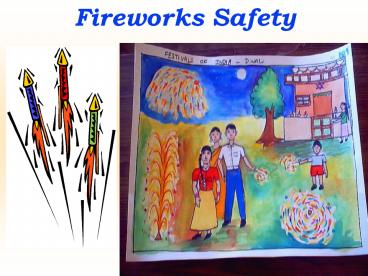Fireworks Safety - PowerPoint PPT Presentation
Title:
Fireworks Safety
Description:
Injuries Boys between the ages of 10 and 14 years have the highest rate of injury. ... Prevention What is ... Illegal firecrackers represent 29% of all firecracker ... – PowerPoint PPT presentation
Number of Views:1800
Avg rating:3.0/5.0
Title: Fireworks Safety
1
Fireworks Safety
2
Overview
- Who is Injured?
- When and Where do Injuries Occur?
- Types of Injuries
- Types of Fireworks
- Prevention Tips
3
The Problem
- How extensive is the problem?
4
The Problem
- Malfunction and careless use of fireworks results
in thousands of injuries annually.
5
Injuries
- Who is most likely to be injured?
6
Injuries
- Over 40 of those injured from fireworks are
children 14 years of age and younger. - Males are injured three times as frequently as
females.
- Boys between the ages of 10 and 14 years have the
highest rate of injury.
7
When and Where
- When and Where Do These Injuries Happen?
8
When and Where
- Injuries occur on and around holidays associated
with fireworks celebrations, especially on
Diwali. - Homes are where most of these injuries occur,
followed by recreational settings, streets or
highways, and parking lots or occupational
settings.
9
Types of Injury
- What kinds of injuries occur?
10
Types of Injury
- Fireworks-related injuries most frequently
involve hands and fingers (38), and eyes (19).
- About half of the injuries are burns, especially
to the face, hand, wrist, or arm. A small
percentage of firework-related injuries lead to
the amputation of hands or fingers.
11
Types of Injury
- Fireworks can be life-threatening. In 1997, seven
people were killed from fireworks-related
injuries.
12
Types of Fireworks
- What types of fireworks are associated with the
most injuries?
13
Types of Fireworks
- Nearly two thirds of fireworks-related injuries
are caused by backyard, "class C" fireworks such
as firecrackers, bottle rockets, Roman candles,
fountains, and sparklers, that are legal in many
states. - Specifically, fireworks-related injuries are most
commonly associated with firecrackers (51),
bottle rockets (12), and sparklers (7).
14
Types of Fireworks
- The most severe injuries are typically caused by
"class B" fireworks, such as rockets, cherry
bombs and M-80s, which are federally banned from
public sale.
- Illegal firecrackers represent 29 of all
firecracker injuries.
15
Prevention
- What is the safest way to prevent fireworks
injuries?
16
Prevention
- Prohibit children less than 14 years old from
using fireworks and supervise older children. - Read and follow all warnings and instructions.
- Only use fireworks outdoors and keep them away
from houses and flammable materials. - When using fireworks, have a bucket of water
nearby.
17
Prevention
- Be sure other people are out-of-range and a safe
distance away before lighting fireworks. - Never ignite fireworks in a container (especially
a glass or metal container). - Never experiment or attempt to make your own
fireworks. - Alcohol and fireworks do NOT mix.
18
Prevention
- Always store your fireworks in a cool dry place.
- Only light one item at a time.
- Never try to re-ignite malfunctioning fireworks.
- Never throw or point fireworks at another person.
- Never carry fireworks in your pocket.
- Always read and FOLLOW directions on the label.
19
Summary
- We advice consumers to leave fireworks to the
professionals
- But if fireworks are legal where you live and you
decide to set them off on your own, be sure to
follow the provided safety tips. - Use Common Sense!
- And Have a Safe Diwali!































